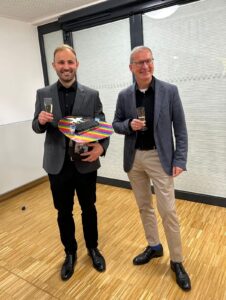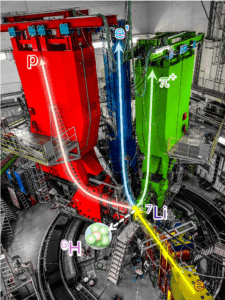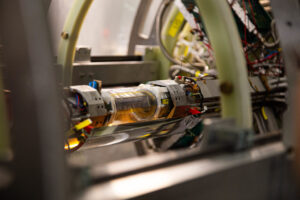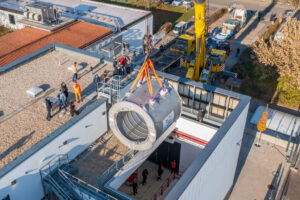 We congratulate Dr. Sebastian Stengel on the successful completion of his dissertation entitled “Design and Development of the MAGIX Trigger Veto System”
We congratulate Dr. Sebastian Stengel on the successful completion of his dissertation entitled “Design and Development of the MAGIX Trigger Veto System”
In his dissertation, Sebastian Stengel developed, implemented, and tested a central detector system for the MAGIX experiment at the new electron accelerator MESA in Mainz.
The versatile MAGIX experiment is designed for high-precision investigations in nuclear and hadron physics, but also opens up other opportunities, including searches for so-called dark photons – hypothetical particles closely related to theories of dark matter. The detection of scattered particles is primarily achieved via two high-resolution magnetic spectrometers.
The focus of the work was the so-called trigger veto system of these spectrometers. It provides a fast and reliable trigger decision for data acquisition, records timing coincidences, and delivers crucial information for particle identification. In addition, it serves as a time reference for the readout of the spectrometer tracking detectors.
The system consists of a segmented trigger layer made of plastic scintillators read out by photomultipliers, as well as a flexible veto system composed of additional scintillator layers equipped with silicon photomultipliers and lead layers for background suppression. The readout is handled by a fast, high-rate FPGA-based electronics system.
Throughout the course of the work, all components of the system were designed, selected, tested, and systematically optimized – including the mechanical design for integration into the spectrometers. Both extensive simulations using Geant4 and comprehensive system tests under realistic experimental conditions were employed.
During a beam time at the MAMI accelerator, the trigger system achieved a remarkable detection efficiency of 99.93%, a time resolution of approximately 180 ps (FWHM), and a spatial resolution of about 25 mm – significantly surpassing the original design requirements. The system is now fully operational and ready for use in the upcoming MAGIX experiment.
The dissertation was carried out within the framework of the MAGIX Collaboration under the supervision of Prof. Achim Denig and impressively documents Sebastian Stengel’s contribution to the preparation of one of the key experiments at the MESA accelerator.
This work stands as an outstanding example of comprehensive, modern experimental detector development – from the conceptual phase to the successful implementation of a complex and high-performance detector system.
 We congratulate Mr. Martin Müller on the successful completion of his dissertation entitled
We congratulate Mr. Martin Müller on the successful completion of his dissertation entitled

 We congratulate Dr. Sebastian Stengel on the successful completion of his dissertation entitled “
We congratulate Dr. Sebastian Stengel on the successful completion of his dissertation entitled “
 We congratulate Dr. Viacheslav Tsaran on completing his dissertation entitled
We congratulate Dr. Viacheslav Tsaran on completing his dissertation entitled
 We congratulate Marius Köppel on the completed dissertation entitled
We congratulate Marius Köppel on the completed dissertation entitled Major award for theoretical physicist of Mainz University and member of the PRISMA+ Cluster of Excellence
Major award for theoretical physicist of Mainz University and member of the PRISMA+ Cluster of Excellence

 strangeness in neutron stars.
strangeness in neutron stars.